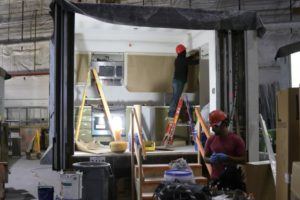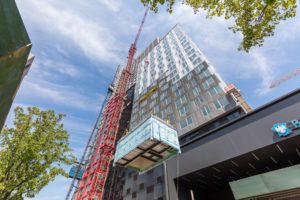Factory-assembled skyscrapers: an episode of The Jetsons, or the future of Real Estate?

Rising land prices, rapid urbanization, and the housing affordability crisis have spurred some real estate developers to digitize construction. Forest City Realty’s bet on high-rise modular construction showcases the evolution of their supply chain—and what can go wrong for early adopters of new technology.
While Amazon deploys delivery drones, the construction industry remains largely unchanged over the past 50 years, resulting in a 10% decline in construction efficiency since WWII.[1] Current megatrends such as rising land prices, rapid urbanization, and the housing affordability crisis have spurred some real estate developers to digitize construction. Forest City Realty (“FRC”), a multi-billionaire developer, first disrupted the industry through high-rise modular construction—32 stories later, 461 Dean Street is the world’s tallest prefabricated apartment building. Its construction showcases the evolution of FCR’s supply chain—and what can go wrong for early adopters of new technology.
Contrary to traditional on-site construction, modular construction involves prefabricating units off-site before stacking them on-site, Lego-style. As part of their master-plan to develop 6,000+ apartments near the Barclays Center, FCR set up a modular factory in the Brooklyn Navy Yard. FCR estimated this would result in cost savings of 20%+ along with saving 4 months on construction.[2] More broadly, the newly automated process would result in safer conditions (e.g. eliminates unpredictable weather), less waste and noise, and would prevent projects from being labor constrained. Instead of waiting for phased building occupancy towards the nearly-completed stage of a building, tenants would immediately move into finished prefabricated units, creating a prototyping- feedback system where developers could tweak factory design to produce better (and higher priced) future units.[3]
FCR first engaged SHoP Architects to create a virtual model, which then passed to the contractor, who translated it into 3D construction documents to Skanska, the Construction Manager. Skanska was responsible for overseeing the factory process, transporting, and assembling the units on-site.[4] The supply chain radically shifted from a linear process into parallel processes. Instead of building floor by floor, the building was constructed all at once, in-factory (e.g. while construction workers were still digging the foundation of the building, electricians were able to work on wiring the units).[5]

Despite technical innovations, Skanska abandoned the project two years later, alleging that FRC’s flawed design caused alignment issues. Counter-suing, FRC claimed the builder botched the process. FCR and the architects conceived of the design, but the contractor had to then translate their work into building instructions. Though FCR spent at least $3.5 million in R&D at the onset, Skanska alleges that narrow design tolerances resulted in tiny errors that, in practice, were compounded through stacking hundreds of pieces.[6] This highlights the difference between the design and construction models—the challenge in modular construction is that developers must shift to a manufacturing model, where the design, development, and construction teams all collaborate from the beginning to understand how pieces will fit together.
Prefabrication requires not only for FCR to develop new technology—but also for every member of its supply chain to change his process. The system necessary to pull off high-rise modular construction must shift from a linear sequence (architects providing the design to engineers, who hand off plans to builders, who then engage contractors) to an integrated design-development construction process. I believe this starts with all the different parties incorporating a much more in-depth prototyping system. Further, there must be greater transparency throughout the supply chain—if defects occur on the factory floor, the design and contractor teams must stay involved and react quickly to change the blueprint going forward. Using multidisciplinary teams would improve the process by incorporating expertise from non-construction industries. Finally, though the industry’s transformation relies on private companies placing their “bets” on adopting new technologies, their adoption can be further encouraged by governments.
After four years of litigation, delayed construction, and monetary write-offs, FCR completed 461 Dean Street in 2016—two years behind schedule. Shortly thereafter, FCR sold its modular construction business, FC Modular, which is currently active for low-rise construction. Though FCR’s attempt to digitize construction “failed” to materialize cost savings, experts estimate that within 10 years, full-scale digitization can lead to up to 21% of cost savings, or as much as $21 billion a year globally.[7]
Google just reportedly invested $30 million in a modular housing start-up to provide affordable housing for its employees in Silicon Valley.[8] FCR’s CEO called the failure of 461 Dean Street “the growing pains of innovation”— what kinds of firms can/should take on real estate innovation, and which player within the supply chain should lead the charge? Would modular construction change things for consumers (tenants)—or would cost savings merely increase developer profits? As technologies like 3-D printing and modular construction grow, what are the implications for the built environment and city planning?
(746 words)
[1] New York Modular. Ryan E. Smith, Peter L. Gluck, Mimi Hoang, Chris Sharples & James Garrison. Journal of Architectural Education Vol. 71 , Iss. 1,2017, https://gluckplus.com/sites/default/files/press_item/files/New%20York%20Modular-small.pdf, accessed November 2017.
[2] Predicting Our Future, “NYC Goes Modular,” March 29, 2017, podcast, https://www.predictingourfuture.com/4-nyc-goes-modular, accessed November 2017.
[3] Velamati, S 2012, “Feasability, benefits and challenges of modular construction in high rise developments in the Unites States: A developer’s perspective”, PhD thesis, MIT, https://dspace.mit.edu/bitstream/handle/1721.1/77129/825120099-MIT.pdf?sequence=2, accessed November 2017.
[4] Diana Budds, “Prefab’s Moment of Reckoning,” Fast Company, Dec 13, 2016, https://www.fastcodesign.com/3066177/prefabs-moment-of-reckoning, accessed November 2017.
[5] Stinson, Elizabeth, “The World’s Tallest Modular Building May Teach Cities to Build Cheaper Housing,” Wired, Nov 23, 2016, https://www.wired.com/2016/11/cities-can-learn-worlds-tallest-modular-building/, accessed November 2017.
[6] Forest City Realty Trust, 2011 Annual Report, p. 51, http://ir.forestcity.net/phoenix.zhtml?c=88464&p=irol-reportsannual, accessed November 2017.
[7] Shaping the Future of Construction. World Economic Forum. p. 23, http://www3.weforum.org/docs/WEF_Shaping_the_Future_of_Construction_full_report__.pdf, accessed November 2017.
[8] Laura Kusisto, “Google Will Buy Modular Homes To Address Housing Crunch,” Wall Street Journal, June 14, 2017, https://www.wsj.com/articles/google-bets-on-modular-homes-to-fill-housing-demand-1497448838, accessed November 2017.





It’s interesting to see the evolution of these companies that basically outsource the manufacturing of a ton of parts and assemble the resulting pieces together. You see a very successful example with auto manufacturers, in which the entire industry does this phenomenally well. But you also see cases of this that are much less successful (e.g., Boeing’s Dreamliner). I’m highly curious as to what the drivers are that enables people to start to predict the success of these ventures.
You highlight building the teams and having everyone work together on it much earlier in the process. Who should be the ones that drive this process change, and once implemented, will it be enough to solve the major problems (e.g., the tolerances that you mention)? If I take the analogy of cars or planes and apply it here, it seems like it’ll be the responsibility of the construction firms on creating these interdisciplinary teams. However, it seems like they may have the least amount of power, as they basically implement a project that’s initiated and designed by the developer/architects. So from that perspective, it seems like the developer will have to be the one that creates these early-stage teams to involve everyone. Would you agree with that, and regardless of who ultimately is responsible for leading the charge, what’s the best way that they can actually create these teams? What are the incentives for everyone to be involved early, when that’s a cost to these firms without any revenues (e.g., I don’t think construction firms will get paid for their inputs on the design of the building). Will firms have to vertically integrate, or how will that work?
Diana, I find pre-fabricated houses a very interesting space. I had looked at it some years ago, thinking about implementing it in Brazil. In high density low-income cities, this could be, once scaled, a very affordable solution to provide popular housing to thousands of people in need. However, I too saw some difficulties that have not yet been solved with this model. As you outlined, I agree that there is a lack of multi-disciplinary teams to drive this innovation. Architects and civil engineers have been trained to construct houses in a different manner and would benefit from having industrial experts in their teams to better develop this field. Hopefully, with time and new technologies such as 3D printing, this will become an affordable constructing method that developing countries could take advantage of.
The not so successful attempt of modular construction by FCR demonstrates how success of technological innovation relies on adaption throughout the supply chain. As the author points out, the traditional players in the real estate industry including designers, engineers, property developers and constructors need to now integrate their work real-time and iteratively as the off-site pre-fabrication and on-site assembly of modular units require constant input from all parties to ensure operational efficiency.
To realize the benefits of modular construction, all players along the supply chain need to not only re-examine their critical tasks (e.g. to what extent should designers be involved off-site and on-site) but also consider how accountability could be enforced given the highly iterative and integrative nature of the production process (e.g. who should bear responsibility for deficiencies in modular units? Does it make a different if it is on-site or off-site?). Clear attribution of accountability will be crucial in this industry to uphold necessary quality and safety standards as defects in building construction could cost precious lives.
I find this space really interesting given that modular construction has been around for as long as I can remember, yet is still seen as “lower quality” and has failed to generate meaningful buy-in despite what would seemingly be clear efficiencies. I wonder at which consumer level a switch to modular housing would be the most effective. Rather than skyscrapers, is it better to target the family-housing market, in which there are fewer parties that need to buy-in and coordinate? Given the experience with FCR at Dean Street, it appears that modular constructiong companies must balance between the level of customization needed (perhaps less on the commercial side vs. family housing side) with the number of parties that must coordinate with each other (more on the commercial side vs. family housing).